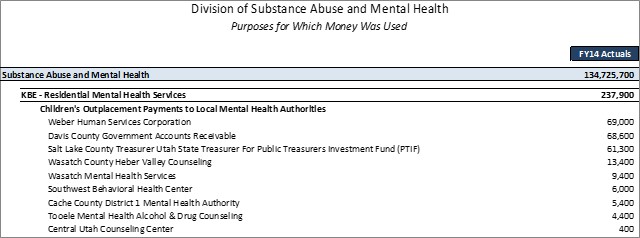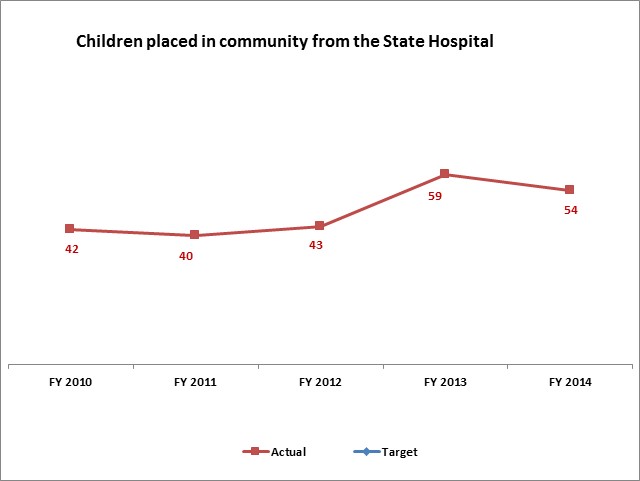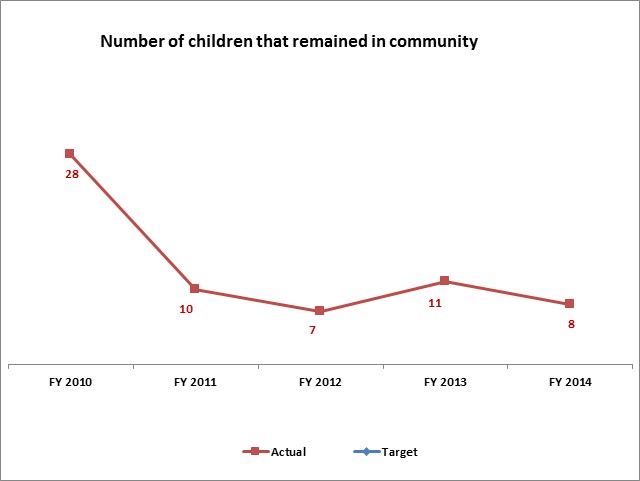The purpose of this program is to provide community-based residential services to children and youth in order to prevent or reduce inpatient hospitalizations. Funding is allocated to mental health providers where adolescents and children are placed. Once children are stabilized, the funding is used to provide wrap-around services that will keep children and youth in their families and communities. The wrap-around services that are developed are specific to the child and family's needs.
During the 2015 General Session, the Legislature appropriated for Fiscal Year 2016, $221,900 from all sources for Residential Mental Health Services. This is a 0 percent change from Fiscal Year 2015 revised estimated amounts from all sources. The total includes $878,900 from the General/Education Funds, a change of 0 percent from revised Fiscal Year 2015 estimates.
For the most recent completed fiscal year, the following information represents the purposes for which the money was used:

Residential Services is considered a statewide service. However, a large portion of the funding is transferred to the divisions of Child and Family Services and Juvenile Justice Services to assist youth transitioning out of the Utah State Hospital. The remaining funding is provided to local mental health authorities and is used for statewide mental health programming for children. "Funds are available statewide. Not all of the Local Mental Health Authorities request funds in any given fiscal year. Funding requests are made and approved based on specific children's needs. If no requests are submitted and approved then no funding is distributed to that local authority . . . The distribution of the funds reflects needs based on the Continuity of Care committee review of individual children's cases. Each of the Local Mental Health Authorities is represented on the committee . . . The merits of each request are discussed by the committee. Funding requires group consensus. The committee approves funding for services not covered by Medicaid or another funding source. Committee review reduces the possibility that funds are diverted to other uses which do not benefit children discharging from the State Hospital or at risk of being housed there . . . The distribution reflects current needs for these types of funds. The number of children requiring outplacement /diversion services and the cost of the services varies significantly for each local authority from one year to the next." Utah code instructs the Division of Substance Abuse and Mental Health to generally allocate funds to the local authorities based upon population. Exceptions to this distribution are outlined in UCA 62A-15-108(2). Residential Mental Health Services is viewed by the division as falling under one of these exceptions."
With regard to how Residential Mental Health Services funds are used by the Division of Juvenile Justice Services (JJS), the agency states, "JJS receives $210,000 annually from the Division of Substance Abuse and Mental Health to assist in taking care of the mental health treatment needs of youths who have been 'carved-out' of the Local Mental Health Authorities as a result of custody being taken from parents and given to JJS by the Juvenile Court. JJS uses the funds to help offset mental health treatment expenses of youths ordered by the Juvenile Court into community placement or long-term secure care. This funding is used to offset part of the transfer to the DOH [Department of Health] and is not specific to any region of the state."
With regard to how Residential Mental Health Services funds are used by the Division of Child and Family Services (DCFS), the agency states, "DCFS receives $447,000 annually from the Division of Substance Abuse and Mental Health to assist in taking care of the mental health needs of children in DCFS custody who have been 'carved-out' of the Local Mental Health systems. DCFS uses the funds to help offset mental health treatment expenses of kids in custody. Services are available to children statewide. This funding is used to offset part of the transfer to the DOH and is not specific to any region of the state."
With regard to the funding used to benefit children discharging from the State Hospital or at risk of being housed there, this funding was originally appropriated by the Legislature to assist in assuring the children and youth do not linger for many years in the State Hospital. At the time of the original appropriation during the mid-1990s, there were youth who had been in the State Hospital as long as 7 years. The State Hospital currently reports that, "the three pediatric patients who have been at the Utah State Hospital the longest are: 1) male, 16 months; 2) female, 10 months (discharge date set for 1/31/15); and 3) female, 10 months. The State Hospital also states that the, "Average Length of Stay (LOS) for Children and Youth Who Discharged During FY13 or FY14 = 302 days (10.1 months). Medican LOS for Children and Youth Who Discharged During FY13 or FY14 = 242 days (8.1 months) . . . Average LOS for patients currently on the unit = 143 days. Median LOS for patients currently on the unit = 126 days." There are currently 48 children at the Utah State Hospital.


Regarding the positive trend greater than 5% in its placement of children in the community from the state hospital performance measure, the agency states, "This number fluctuates up and down annually because the population is a very narrow group of youth who are experiencing significant barriers to discharge from the Utah State Hospital. With assistance to overcome these barriers, youth can discharge earlier than they would be able to without these extra supports in place. This area will always experience significant fluctuations due to do the small number of youth involved and the needs associated with each of these youth with complex mental health needs."
Regarding the negative trend greater than 5% in its number of children that remained in the community from the state hospital performance measure, the agency states, "This specifically identifies a small number of youth who are highly likely to require admission to the Utah State Hospital. In some unique situations, there was an opportunity for specialized intervention which successfully diverted admission to the Utah State Hospital."
COBI contains unaudited data as presented to the Legislature by state agencies at the time of publication. For audited financial data see the State of Utah's Comprehensive Annual Financial Reports.